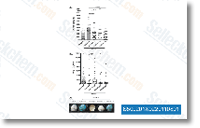In lung cancer cells, treatment with cisplatin, doxorubicin, or etoposide resulted from the variety of cancer stem cells as indicated by cell biology and evaluation of expression of stemness genes, These chemotherapy chosen cancer stem cells were responsible for the observed improved professional angiogenic properties of lung cancer cells. Inside the absence of cytotoxic medicines, lung cancer cell lines returned to their preliminary phenotype and re acquired drug sensitivity, In contrast, UKF NB 3rVCR10 and UKF NB 3rCDDP1000 cells remained chem oresistant and didn’t loose their pro angiogenic pheno form even if they have been cultivated for up to 6 months within the absence of drugs, This suggests that chemoresistance and pro angiogenic activity in these cell lines aren’t consequence of a uncomplicated chemotherapy induced selection of cancer stem cells which are currently current during the parental UKF NB three cell line.
Furthermore, acute cisplatin therapy increased VEGF expression together with expression on the stemness genes Nanog, Bmi one, and Oct 4 in osteosarcoma, rhabdomyosa rcoma and neuroblastoma cell lines, However, none of those stemness genes ms-275 structure was uncovered up regulated in UKF NB 3rVCR10 or UKF NB 3rCDDP1000 cells relative to UKF NB purchase Givinostat three cells, The finding that cell culture supernatants from chemore sistant cells exerted more powerful professional angiogenic effects than these from chemosensitive cells suggests that soluble fac tors contribute to your enhanced professional angiogenic activity exerted by chemoresistant neuroblastoma cells. Statistical examination of the expression of angiogenesis linked genes indicated clear variations concerning chemosensitive UKF NB 3 cells as well as the chemoresistant sub lines UKF NB 3rVCR10, UKF NB 3rCDDP1000, or UKF NB 3rDOX20, Obviously, chemore sistance growth resulted inside a global transform of expression of angiogenesis associated genes in the direction of a more pro angiogenic phenotype.
The resistance linked improvements in expression patterns appear to differ involving individual chemoresistant neuroblastoma cell lines. This suggests the enhanced pro angiogenic phenotype observed in all  chemoresistant neuroblastoma cell lines in comparison on the chemosensitive cell lines is caused by various changes in the expression patterns of angiogenesis linked genes. Notably, hierarchical clustering of expression of angiogenesis related genes also clearly discriminated UKF NB two cells from UKF NB 2rVCR10 and UKF NB 2rCDDP1000 cells, also as IMR 32 cells from IMR 32rVCR10 cells, The see that person chemoresistant neuroblastoma cell lines exert professional angiogenic results by individual mech anisms is supported by the benefits derived from your examination ination of pro angiogenic signalling in endothelial cells incubated with supernatants from distinctive neuroblast oma cell lines.
chemoresistant neuroblastoma cell lines in comparison on the chemosensitive cell lines is caused by various changes in the expression patterns of angiogenesis linked genes. Notably, hierarchical clustering of expression of angiogenesis related genes also clearly discriminated UKF NB two cells from UKF NB 2rVCR10 and UKF NB 2rCDDP1000 cells, also as IMR 32 cells from IMR 32rVCR10 cells, The see that person chemoresistant neuroblastoma cell lines exert professional angiogenic results by individual mech anisms is supported by the benefits derived from your examination ination of pro angiogenic signalling in endothelial cells incubated with supernatants from distinctive neuroblast oma cell lines.
PKA Signal
PKA signal is required for initiation
